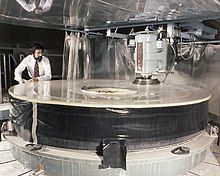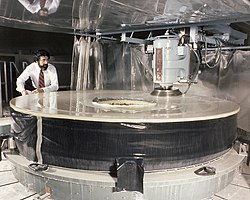Ultra low expansion glass

Ultra low expansion glass (kurz ULE) ist ein SiO2-TiO2-Glas der Firma Corning, das einen sehr kleinen Wärmeausdehnungskoeffizienten besitzt.[1] Es wird als Träger für große Teleskopspiegel in Spiegelteleskopen eingesetzt,[1] beispielsweise im Hubble-Weltraumteleskop oder im Subaru-Teleskop.[2]
Siehe auch
Andere Materialien mit kleiner Wärmeausdehnung sind Glaskeramiken, Quarzglas oder die Metalllegierung Super Invar.
Einzelnachweise
- ↑ a b ULE® Corning Code 7972 Ultra Low Expansion Glass Advanced Optics and Materials. Corning Incorporated, 2016, abgerufen am 21. Februar 2021.
- ↑ Julie Spangenberg-Jolley: Large mirror fabrication of low expansion glasses. In: Astrophysics and Space Science. Band 160, Nr. 1-2, 1989, S. 199–205, bibcode:1989Ap&SS.160..199S.
Auf dieser Seite verwendete Medien
Hubble Space Telescope Primary Mirror: This photograph shows the Hubble Space Telescope's (HST's) Primary Mirror being ground at the Perkin-Elmer Corporation's large optics fabrication facility. After the 8-foot diameter mirror was ground to shape and polished, the glass surface was coated with a reflective layer of aluminum and a protective layer of magnesium fluoride, 0.1- and 0.025-micrometers thick, respectively. The purpose of the HST, the most complex and sensitive optical telescope ever made, is to study the cosmos from a low-Earth orbit. By placing the telescope in space, astronomers are able to collect data that is free of the Earth's atmosphere. The Marshall Space Flight Center had responsibility for design, development, and construction of the HST and the Perkin-Elmer Corporation, in Danbury, Connecticut, developed the optical system and guidance sensors.
